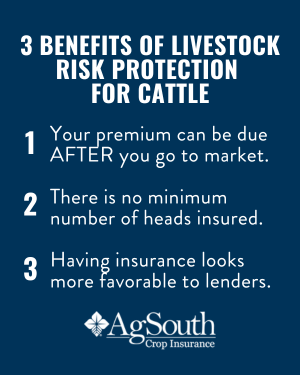Understanding Animals Danger Defense (LRP) Insurance Coverage: A Comprehensive Guide
Browsing the realm of livestock danger security (LRP) insurance can be an intricate venture for numerous in the agricultural industry. From how LRP insurance works to the different insurance coverage options readily available, there is much to uncover in this comprehensive overview that could potentially form the method livestock producers approach danger management in their organizations.

Exactly How LRP Insurance Coverage Functions
Periodically, understanding the mechanics of Animals Risk Protection (LRP) insurance coverage can be complicated, however damaging down how it works can offer clearness for farmers and breeders. LRP insurance coverage is a risk monitoring tool designed to safeguard animals manufacturers versus unanticipated rate declines. It's important to keep in mind that LRP insurance is not an earnings guarantee; rather, it focuses exclusively on cost danger security.
Eligibility and Protection Options

When it comes to protection choices, LRP insurance policy supplies manufacturers the adaptability to pick the insurance coverage degree, insurance coverage duration, and recommendations that best suit their risk management needs. By comprehending the eligibility criteria and insurance coverage alternatives readily available, animals producers can make informed decisions to take care of danger properly.
Benefits And Drawbacks of LRP Insurance Policy
When examining Livestock Danger Security (LRP) insurance policy, it is crucial for livestock producers to evaluate the advantages and downsides fundamental in this risk management device.

One of the main benefits of LRP insurance is its ability to provide defense against a decline in livestock prices. Furthermore, LRP insurance coverage uses a level of versatility, enabling producers to tailor protection levels and plan durations to fit their certain requirements.
Nonetheless, there are also some downsides to consider. One limitation of LRP insurance is that it does not secure versus all sorts of dangers, such as illness break outs or all-natural catastrophes. Additionally, premiums can often be expensive, particularly for producers with large livestock herds. It is critical for manufacturers to meticulously examine their specific danger exposure and economic circumstance to figure out if LRP insurance coverage is the right risk monitoring device for their operation.
Recognizing LRP Insurance Policy Premiums

Tips for Taking Full Advantage Of LRP Advantages
Maximizing the benefits of Animals Danger Defense (LRP) insurance needs critical planning and positive danger monitoring - Bagley Risk Management. To maximize your LRP insurance coverage, think about the adhering to ideas:
Frequently Analyze Market Conditions: Stay educated about market trends and price fluctuations in the livestock industry. By keeping an eye on important site these aspects, you can make educated choices regarding when to buy LRP insurance coverage to shield versus possible losses.
Establish Realistic Coverage Degrees: When selecting insurance coverage levels, consider your production costs, market price of livestock, and prospective dangers - Bagley Risk Management. Setting reasonable insurance coverage levels makes certain that you are properly protected without overpaying for unneeded insurance policy
Expand Your Coverage: Instead of relying only on LRP insurance, consider expanding your danger administration approaches. Incorporating LRP with other risk management tools such as futures agreements or choices can provide extensive coverage versus market uncertainties.
Review and Adjust Insurance Coverage On a regular basis: As market conditions alter, periodically assess your LRP protection to ensure it lines up with your current danger exposure. Changing coverage levels and timing of acquisitions can assist optimize your threat protection approach. By adhering to these ideas, you can maximize the advantages of LRP insurance and protect your animals operation versus unforeseen risks.
Verdict
In conclusion, livestock risk defense (LRP) insurance policy is a useful device for farmers to handle the monetary dangers associated with their animals procedures. By recognizing how LRP works, eligibility and coverage alternatives, as well as the pros and cons of this insurance, farmers can make enlightened decisions to safeguard their resources. By carefully taking into consideration LRP premiums and implementing approaches to make the most of benefits, farmers can alleviate possible losses and ensure the sustainability of their operations.
Livestock producers interested in getting Livestock Threat Defense (LRP) insurance can check out an array of qualification standards and coverage choices customized to their details livestock procedures.When it comes to protection options, LRP insurance coverage supplies manufacturers the flexibility to pick the protection degree, protection period, and recommendations that ideal match their threat monitoring demands.To grasp the ins and outs of Livestock Danger Defense (LRP) insurance policy completely, comprehending the aspects affecting LRP insurance coverage premiums is important. LRP insurance costs are established by different aspects, including the coverage degree selected, the expected rate of animals at the end of the insurance coverage duration, the type of livestock being guaranteed, and the length of the coverage duration.Evaluation and his explanation Adjust Insurance Coverage Routinely: As market problems alter, periodically review your LRP protection to guarantee it lines up with your current threat direct exposure.